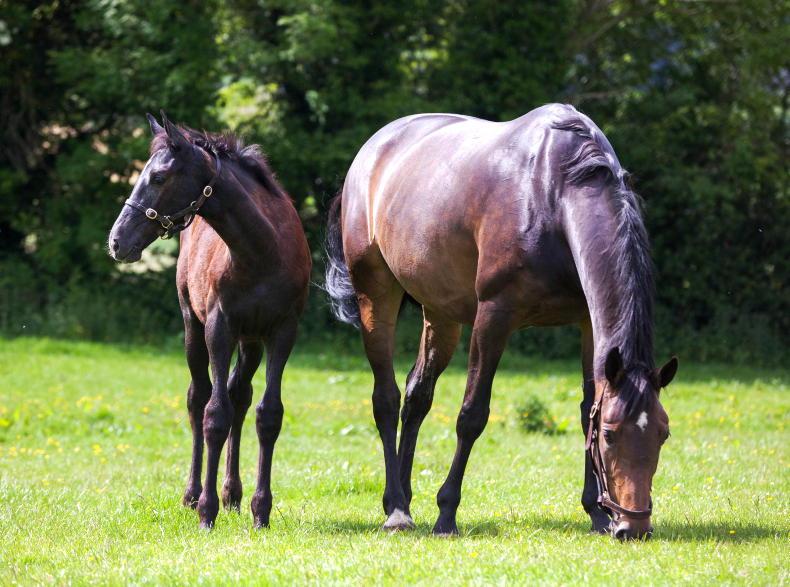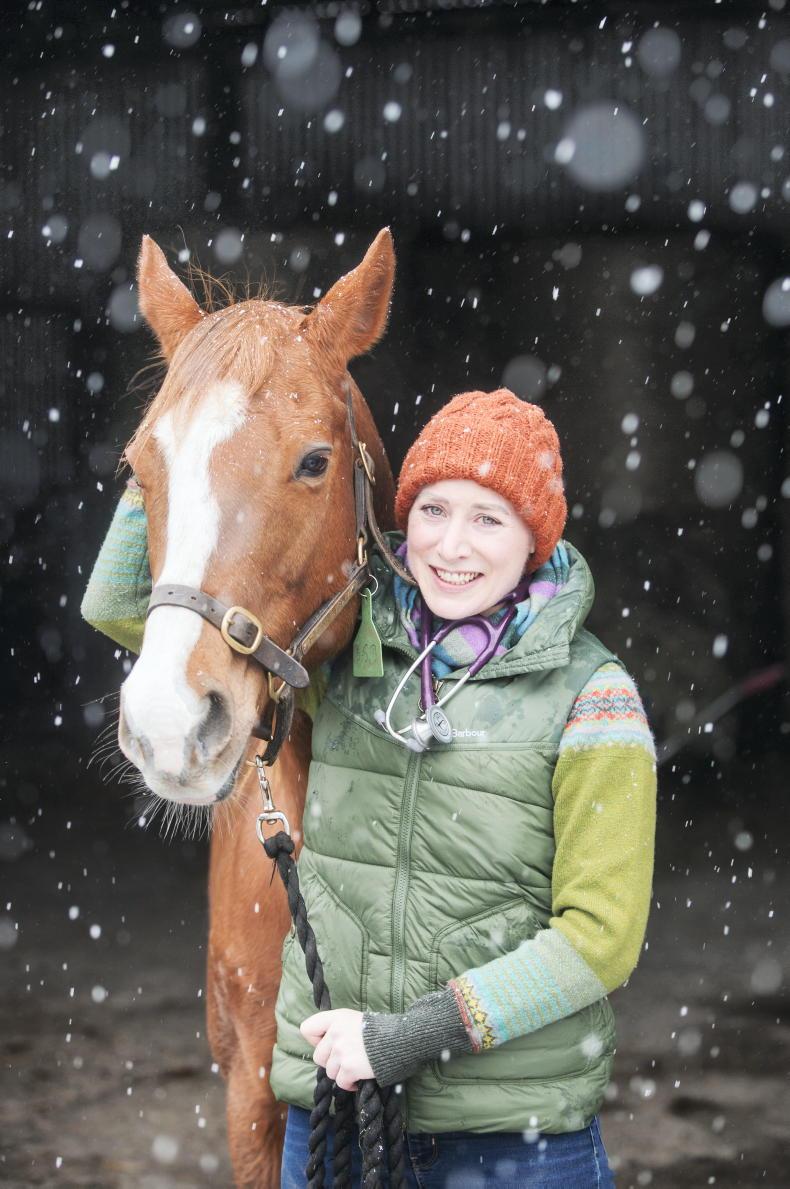Dr Susan Salter heads up SES Equine Veterinary Services on the Kildare/Wicklow border. Sue and her team cover all aspects of equine reproduction and stud medicine for both sport horse and thoroughbred stud farms and clients, including an embryo flush and transfer service and guidance on OPU and ICSI options. The team also offers a specialised service aimed at getting subfertile mares in foal, managing high-risk pregnancies and caring for foals and youngstock.
Despite only opening its doors in 2021, Sue’s practice has developed a respected reputation in just a few years. For our 2024 supplement, Sue has addressed some of the most pertinent questions from breeders this season. Also, alongside her colleague and fellow Irish Equine Veterinary Association (IEVA) panel member, Dr Sarah Ross, a board certified medicine specialist working at the Irish Equine centre, Sue will answer more breeders’ questions in our podcast, ‘Sport Horse Breeding: Bloodlines, Sweat and Tears’ available on farmersjournal.ie and theirishfield.ie.
How should you best prepare your mare for covering?
Approaches to preparing a mare for cover vary somewhat depending on the profile of the mare; whether she is young or old; has a foal at foot; and whether or not she has had previous fertility complications.
As a baseline, it is highly recommended to have your mare checked for venereal bacterial and blood-borne viral STDs which may impact your mare’s fertility and ability to conceive. These diseases include contagious equine metritis (CEM) which is an umbrella term for a number of venereal pathogens; Taylorella equigenitalis, Klebsiella pneumoniae and Pseudomonas aeruginosa.
Both clitoral and endometrial swab samples can be used to screen for CEM. Capsule typing may be required to identify pathogenic types in the Klebsiella bacterial family. Should either Klebsiella or Pseudomonas be identified, treatment based on bacterial sensitivity can be implemented to treat these infections. Blood samples are taken to test for EVA (Equine Viral Arteritis) and EIA (Equine Infectious Anaemia) at an approved laboratory. These initial screening techniques are relatively inexpensive and are commonplace in sport horse breeding across the UK and Europe.
We recommend that all mares, whether being bred via artificial insemination or via live cover, are screened and tested for these diseases. We encourage all stallion farms to screen for the same diseases in their stallions. This year, Horse Sport Ireland is giving a voucher to the value of €50 to encourage people to test for these diseases.
Barren mares
Should your mare be bred via artificial insemination to either frozen semen or chilled semen arriving from abroad, we highly recommend that you skip the first cycle of the season in barren and maiden mares and the first cycle i.e. foal heat in mares with foals at foot. Both barren mares and maidens tend to show a less reliable response to ovulation agents during their first cycle compared to subsequent cycles. This is particularly relevant when seeking a very precise ovulation window e.g. when using frozen semen or chilled semen from overseas. Of course, one can still utilise the first cycle of the season but it is important to remember that it can be less reliable. Foal heat is not the ideal cycle to use as the uterus has not yet involuted and even when the mare goes in foal, this cycle is still associated with higher incidence of early embryonic loss. Where time permits, we advise readers to skip foal heat and the first cycle of the season. Focusing on the mare’s overall health is of extreme importance. Ensuring that her body condition score is adequate; her teeth and feet are properly maintained; and that she is correctly de-wormed based only on correct interpretation of history and faecal worm egg count results, will inevitably increase your mare’s chances of going in foal.

Should I give my mare antibiotics once a month when pregnant to prevent red bag presentation?
The practice of prophylactic antibiotic usage without a reasonable indication is not warranted and is not cost effective. Prophylactic use of antibiotics is inappropriate and may contribute to the birth of resistant bugs such as MRSA.
The author has referred many mares annually to get in foal and to maintain in foal until full term. Many have a previous history of placentitis, subsequent red bag development and other complications.
Prior to getting the mare in foal, we focus largely on the subtleties of the clinical examination e.g. cervical function and on information drawn from biopsies and other diagnostics.
If treatment is indicated then we treat prior to breeding. In some cases, a caslick’s procedure alone will reduce the risk of ascending infection which can cause bacterial placentitis and red bag development.
When the mare is pregnant, we perform ultrasonography at reasonable intervals throughout pregnancy to assess foetal and placental health. Treatment is based on identifying abnormalities on scan and on clinical examination. Rarely do we find reasons to warrant the use of antibiotics but when we do it is based on true clinical signs of placentitis; for example, vulval discharge.
Risk factors
In essence, if your mare has previously had a red bag presentation, we encourage you to consider a clincial examination and work-up prior to re-breeding so as to identify and treat problems and risk factors found before embarking on putting her in foal. If antibiotics are warranted at any stage, then it is important to ensure correct dosing by weight, interval and duration. Strictly follow veterinary instructions when using antibiotics.

Dr Susan Salter and her team offer a wrap around veterinary service for both sport horse and thoroughhbred breeders. \ Claire Nash
Is an enema recommended in the new born foal?
Yes, it certainly is. But an enema alone is a short-sighted simplified approach to ensuring that a meconium impaction doesn’t occur. Meconium is the foal’s first droppings which needs to be evacuated from the foal soon after birth or the animal will colic.
A foal that gets up and drinks milk will not only maintain an optimal hydration status which is needed to pass meconium but acid in the milk will also break down and soften the hard droppings sitting in the foal’s GI tract. If for some reason the foal does not drink (consider mare and foal factors), then this process will be interrupted which could lead to a meconium impaction colic. Prophylactic use of one to two enemas is good practice. However, watching for normal behaviour as described here is considered more fundamental to the passing of meconium.
What is a false ovulation?
In short, there is no such thing. A mare either ovulates or she does not. However, this term is used colloquially to describe anovulatory follicles - follicles which looked like they could have ovulated but did not. Anovulatory follicles can be categorised as:
HAF (hemorrhagic anovulatory follicles), which by true definition, do not produce progesterone and therefore, do not cause any subsequent delays, or LUFS (luteinising unruptured follicles) which, by definition, do not ovulate but do luteinise meaning that they subsequently produce progesterone just like a corpus luteum (CL). However, they tend not to disappear 16 days after their development as a normal CL would.
Instead, they tend to persist and disrupt the mare’s normal cyclicity and can be cumbersome to eradicate.
The author chooses to use larger doses of prostaglandin at timed intervals on mature LUFs to eradicate them. There is an array of interchangeable terms used to describe both phenomena mentioned here e.g. autumn follicles.
Research has been performed by John Newcombe and Juan Cuervo Arango for example, on how these structures may present on ultrasound. Arango’s research has also shown that the use of some anti-inflammatories around covering time can lead to ovulation failure and the development of HAF/LUF.
Most effective
Ultimately, it is the author’s opinion that in practice, a true HAF will not cause significant delays while LUFs will cause significant delays by putting a mare out of season. Although there is conflicting research into the use of prostaglandin to eradicate LUFs, it is currently the most effective and practical method available for clinical use in the breeding shed.
Find out more about SES Equine Veterinary Services at sesequinevets.ie or by following them on Instagram or Facebook. You can call their friendly team on +353 87 603 6006 or email sesveterinary@gmail.com
‘Sport Horse Breeding: Bloodlines, Sweat and Tears’ available on farmersjournal.ie and theirishfield.ie

Dr Susan Salter heads up SES Equine Veterinary Services on the Kildare/Wicklow border. Sue and her team cover all aspects of equine reproduction and stud medicine for both sport horse and thoroughbred stud farms and clients, including an embryo flush and transfer service and guidance on OPU and ICSI options. The team also offers a specialised service aimed at getting subfertile mares in foal, managing high-risk pregnancies and caring for foals and youngstock.
Despite only opening its doors in 2021, Sue’s practice has developed a respected reputation in just a few years. For our 2024 supplement, Sue has addressed some of the most pertinent questions from breeders this season. Also, alongside her colleague and fellow Irish Equine Veterinary Association (IEVA) panel member, Dr Sarah Ross, a board certified medicine specialist working at the Irish Equine centre, Sue will answer more breeders’ questions in our podcast, ‘Sport Horse Breeding: Bloodlines, Sweat and Tears’ available on farmersjournal.ie and theirishfield.ie.
How should you best prepare your mare for covering?
Approaches to preparing a mare for cover vary somewhat depending on the profile of the mare; whether she is young or old; has a foal at foot; and whether or not she has had previous fertility complications.
As a baseline, it is highly recommended to have your mare checked for venereal bacterial and blood-borne viral STDs which may impact your mare’s fertility and ability to conceive. These diseases include contagious equine metritis (CEM) which is an umbrella term for a number of venereal pathogens; Taylorella equigenitalis, Klebsiella pneumoniae and Pseudomonas aeruginosa.
Both clitoral and endometrial swab samples can be used to screen for CEM. Capsule typing may be required to identify pathogenic types in the Klebsiella bacterial family. Should either Klebsiella or Pseudomonas be identified, treatment based on bacterial sensitivity can be implemented to treat these infections. Blood samples are taken to test for EVA (Equine Viral Arteritis) and EIA (Equine Infectious Anaemia) at an approved laboratory. These initial screening techniques are relatively inexpensive and are commonplace in sport horse breeding across the UK and Europe.
We recommend that all mares, whether being bred via artificial insemination or via live cover, are screened and tested for these diseases. We encourage all stallion farms to screen for the same diseases in their stallions. This year, Horse Sport Ireland is giving a voucher to the value of €50 to encourage people to test for these diseases.
Barren mares
Should your mare be bred via artificial insemination to either frozen semen or chilled semen arriving from abroad, we highly recommend that you skip the first cycle of the season in barren and maiden mares and the first cycle i.e. foal heat in mares with foals at foot. Both barren mares and maidens tend to show a less reliable response to ovulation agents during their first cycle compared to subsequent cycles. This is particularly relevant when seeking a very precise ovulation window e.g. when using frozen semen or chilled semen from overseas. Of course, one can still utilise the first cycle of the season but it is important to remember that it can be less reliable. Foal heat is not the ideal cycle to use as the uterus has not yet involuted and even when the mare goes in foal, this cycle is still associated with higher incidence of early embryonic loss. Where time permits, we advise readers to skip foal heat and the first cycle of the season. Focusing on the mare’s overall health is of extreme importance. Ensuring that her body condition score is adequate; her teeth and feet are properly maintained; and that she is correctly de-wormed based only on correct interpretation of history and faecal worm egg count results, will inevitably increase your mare’s chances of going in foal.

Should I give my mare antibiotics once a month when pregnant to prevent red bag presentation?
The practice of prophylactic antibiotic usage without a reasonable indication is not warranted and is not cost effective. Prophylactic use of antibiotics is inappropriate and may contribute to the birth of resistant bugs such as MRSA.
The author has referred many mares annually to get in foal and to maintain in foal until full term. Many have a previous history of placentitis, subsequent red bag development and other complications.
Prior to getting the mare in foal, we focus largely on the subtleties of the clinical examination e.g. cervical function and on information drawn from biopsies and other diagnostics.
If treatment is indicated then we treat prior to breeding. In some cases, a caslick’s procedure alone will reduce the risk of ascending infection which can cause bacterial placentitis and red bag development.
When the mare is pregnant, we perform ultrasonography at reasonable intervals throughout pregnancy to assess foetal and placental health. Treatment is based on identifying abnormalities on scan and on clinical examination. Rarely do we find reasons to warrant the use of antibiotics but when we do it is based on true clinical signs of placentitis; for example, vulval discharge.
Risk factors
In essence, if your mare has previously had a red bag presentation, we encourage you to consider a clincial examination and work-up prior to re-breeding so as to identify and treat problems and risk factors found before embarking on putting her in foal. If antibiotics are warranted at any stage, then it is important to ensure correct dosing by weight, interval and duration. Strictly follow veterinary instructions when using antibiotics.

Dr Susan Salter and her team offer a wrap around veterinary service for both sport horse and thoroughhbred breeders. \ Claire Nash
Is an enema recommended in the new born foal?
Yes, it certainly is. But an enema alone is a short-sighted simplified approach to ensuring that a meconium impaction doesn’t occur. Meconium is the foal’s first droppings which needs to be evacuated from the foal soon after birth or the animal will colic.
A foal that gets up and drinks milk will not only maintain an optimal hydration status which is needed to pass meconium but acid in the milk will also break down and soften the hard droppings sitting in the foal’s GI tract. If for some reason the foal does not drink (consider mare and foal factors), then this process will be interrupted which could lead to a meconium impaction colic. Prophylactic use of one to two enemas is good practice. However, watching for normal behaviour as described here is considered more fundamental to the passing of meconium.
What is a false ovulation?
In short, there is no such thing. A mare either ovulates or she does not. However, this term is used colloquially to describe anovulatory follicles - follicles which looked like they could have ovulated but did not. Anovulatory follicles can be categorised as:
HAF (hemorrhagic anovulatory follicles), which by true definition, do not produce progesterone and therefore, do not cause any subsequent delays, or LUFS (luteinising unruptured follicles) which, by definition, do not ovulate but do luteinise meaning that they subsequently produce progesterone just like a corpus luteum (CL). However, they tend not to disappear 16 days after their development as a normal CL would.
Instead, they tend to persist and disrupt the mare’s normal cyclicity and can be cumbersome to eradicate.
The author chooses to use larger doses of prostaglandin at timed intervals on mature LUFs to eradicate them. There is an array of interchangeable terms used to describe both phenomena mentioned here e.g. autumn follicles.
Research has been performed by John Newcombe and Juan Cuervo Arango for example, on how these structures may present on ultrasound. Arango’s research has also shown that the use of some anti-inflammatories around covering time can lead to ovulation failure and the development of HAF/LUF.
Most effective
Ultimately, it is the author’s opinion that in practice, a true HAF will not cause significant delays while LUFs will cause significant delays by putting a mare out of season. Although there is conflicting research into the use of prostaglandin to eradicate LUFs, it is currently the most effective and practical method available for clinical use in the breeding shed.
Find out more about SES Equine Veterinary Services at sesequinevets.ie or by following them on Instagram or Facebook. You can call their friendly team on +353 87 603 6006 or email sesveterinary@gmail.com
‘Sport Horse Breeding: Bloodlines, Sweat and Tears’ available on farmersjournal.ie and theirishfield.ie










 This is a subscriber-only article
This is a subscriber-only article










SHARING OPTIONS: